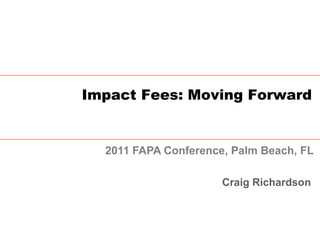
9/9 FRI 2:45 | How to Pay for Growth - Impact Fees 1
- 1. Impact Fees: Moving Forward 2011 FAPA Conference, Palm Beach, FL Craig Richardson
- 2. Introduction Introduction Background Current Environment Relationship of Fees and Growth/Development Conclusions
- 3. Background 1970s: Growth in Florida places tremendous pressures on demand for public facilities State and local government structure for funding public facilities Local political conditions Late 1970s: Handful of local governments explore use of impact fees to fund public facilities, and adopt ordinances Palm Beach and Broward counties lead the way Impact fees untested in courts Early 1980s: Palm Beach and Broward county ordinances challenged in courts
- 4. Background Early 1980s: Broward and Palm Beach counties successfully defend local governments use of impact fees Early 1980s: Cases established fundamental ground rules for local government use of impact fees Local government powers to adopt impact fees emanate for state constitutional home rule powers
- 5. Background Early 1980s: Cases established fundamental ground rules (cont.) Compliance with dual rational nexus standard required… the local government must demonstrate a reasonable connection, or rational nexus, between the need for additional capital facilities and the growth in population generated by the subdivision. In addition, the government must show a reasonable connection, or rational nexus between the expenditure of the funds collected and the benefits accruing to the subdivision. In order to satisfy this later requirement, the ordinance must specifically earmark the funds collected for use in acquiring capital facilities to benefit the new residents.” Hollywood, Inc. General presumption of validity
- 6. Background Balance of 1980s: Significant expansion of local government use of impact fees, extending into 1990s Heaviest use in coastal communities in southeast and southwest Florida Use expanded to include a number of additional public facilities: Roads Parks Water/Sewage Police Fire/EMS Schools Other (Solid Wastes, Libraries, Government Buildings)
- 7. Background Balance of 1980s into 90s:Limited litigation over impact fees during these years, with one exception Local governments authority and right to adopt school fees upheld by Florida Supreme Court in St Johns County v. Northeast Florida Homebuilders Justice Grimes, who wrote the appellate court opinion in Dunedin, wrote the opinion for the court Reaffirmed rational nexus standard applies to impact fees, while establishing additional parameters for school fees Decision opened the door even more for local governments use of impact fees At this point question was whether or if state legislature would step in and attempt to place limits on the imposition of fees – which they did not
- 8. Background Balance of 1990s into 2000s: Local governments continued to expand the use of impact fees By 2007, 42 counties had adopted e fee programs Many local governments updated and added fees In most instances updates resulted in increases in fee amounts (especially as costs and housing prices continued to rise) Not unusua, by the early 2000s in many counties for the total fees to be over $15,000 Resulted in some litigation School fees Primary issue -- whether calculations complied with rational nexus standard In mid 2000s several local governments adopted affordable housing fee programs
- 9. Current Environment Great Recession and Aftermath Substantial economic downturn and decrease in home values In many communities, substantial inventory of housing Dramatic decrease in building Political attitude about imposition of fees changed Fee suspensions, reductions, and in limited instances abolishment State legislature shifts burden to local governments to demonstrate compliance with rational nexus standards Continued limitations on local government capacity to raise revenue for capital public facilities Significant amendments to growth management laws, including general loss of concurrency mandate (even though can still impose requirements)
- 10. Conclusions While economic and legislative climate toward growth management has changed, much has not with respect to impact fees When growth and development picks up, there will be a need for funding for capital facilities to accommodate Limited state funding Continued legal limitations on local government ability to raise revenue Local political considerations Impact fees still a viable source of funding for capital public facilities The concept that growth should pay for itself is alive and well, and impact fees are a way to ensure it does
- 11. Conclusions While economic and legislative climate toward growth management has changed, much has not with respect to impact fees (cont.) Even with the shifting of burden to local government to demonstrate compliance with rational nexus standard, standard for adoption has not changed Good local government support studies met this burden Important to remember burden has shifted, and support studies must use professionally accepted methods and reasonable/sound information to calculate fees Good news: methods are available; sound information can be found Authority to adopt fees emanates from state constitution Some local governments might rely more on assessments
- 12. QUESTIONS
